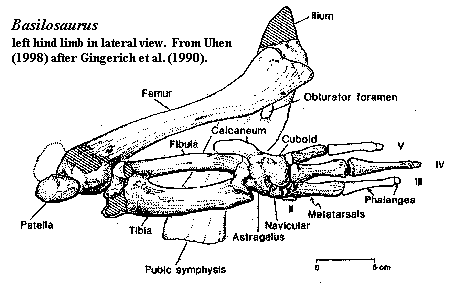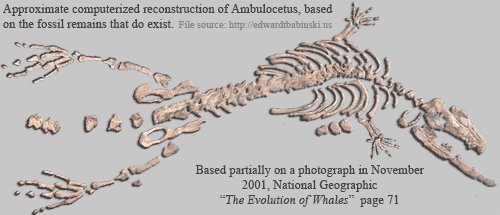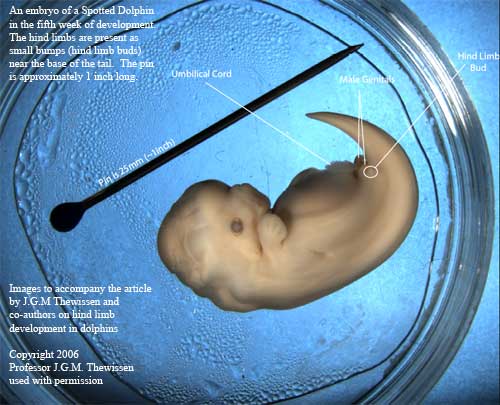To: Stultis
This is the kind of crap you guys are always quoting. If you only have the skull, how in the hell do you know if it had fins or legs. I've seen some of your proof which consisted of bones where legs should be but turned into a fin. Now they say it used to be a leg. Yeah right. I'll tell you what, you show me a true whale of any age and show me the four legs on it. Then you can show me an ape that is a man or even part man. Then when you finish that, oh, never mind. I know it's impossible because even in old bones they just don't exist.
To: fish hawk
Then you can show me an ape that is a man or even part man. Then when you finish that, oh, never mind. I know it's impossible because even in old bones they just don't exist. This is a transitional. Note its position in the chart which follows (hint--in the upper center):
Fossil: KNM-ER 3733

Site: Koobi Fora (Upper KBS tuff, area 104), Lake Turkana, Kenya (4, 1)
Discovered By: B. Ngeneo, 1975 (1)
Estimated Age of Fossil: 1.75 mya * determined by Stratigraphic, faunal, paleomagnetic & radiometric data (1, 4)
Species Name: Homo ergaster (1, 7, 8), Homo erectus (3, 4, 7), Homo erectus ergaster (25)
Gender: Female (species presumed to be sexually dimorphic) (1, 8)
Cranial Capacity: 850 cc (1, 3, 4)
Information: Tools found in same layer (8, 9). Found with KNM-ER 406 A. boisei (effectively eliminating single species hypothesis) (1)
Interpretation: Adult (based on cranial sutures, molar eruption and dental wear) (1)
See original source for notes:
Source: http://www.mos.org/evolution/fossils/fossilview.php?fid=33

Source: http://wwwrses.anu.edu.au/environment/eePages/eeDating/HumanEvol_info.html
486 posted on
08/28/2006 9:46:29 PM PDT by
Coyoteman
(I love the sound of beta decay in the morning!)
To: fish hawk; Stultis
If you only have the skull, how in the hell do you know if it had fins or legs. Who said that they only had a skull?
I'm not sure which is more alarming - the inability to properly read someone else's post, or presuming to lecture someone else on something where you're obviously clueless.
Mash on the link below to see an excavation of Basilosaurus isis:
http://www-personal.umich.edu/~gingeric/PDGwhales/PDG20050233.jpg
Does that really look like "only" a skull?
In case you're wondering why nobody takes your objections especially seriously, it's because you haven't got any serious objections. Just fantasy objections.
487 posted on
08/28/2006 10:04:06 PM PDT by
Senator Bedfellow
(If you're not sure, it was probably sarcasm.)
To: fish hawk
Whale with four legs:
Ambulocetus, or you could examine any of the examples of modern whales found with vestigial hind legs and the way that hind legs start to develop in whale embryos but are resorbed during development.
Fish with transitional fin/legs: Tiktaalik.
"Ape-man," primitive hominid: Australopithecus.
Brought to you by Darwin Central, the Conspiracy that Cares(TM). Always glad to be of help.
504 posted on
08/29/2006 3:46:22 AM PDT by
ahayes
("If intelligent design evolved from creationism, then why are there still creationists?"--Quark2005)
To: fish hawk
If you only have the skull, how in the hell do you know if it had fins or legs. We don't. We have virtually complete skeletons of Basilosaurus isis. (Although the species was known for many years before a particularly complete specimen revealed that it had very small, but perfectly formed, rear legs and feet.)
I just made the comment about the "skull alone" probably being too heavy to lift because you'd said you couldn't fill a single hand with the evidence of transitional forms. (Actually you said "missing links".)
... if it had fins or legs.
Uh, btw, whales don't have "fins" in the position of the front limbs. They're called "flippers". Granted whales do have a "dorsal 'fin'," but of course it's entirely different in structure and developmental origin from the fins of fishes, as of course is predicted and required by evolution since whales evolved from terrestrial tetrapods (land animals) that had long ago lost their fishy fins.
I've seen some of your proof which consisted of bones where legs should be but turned into a fin.
??? I can't make out what you're trying to say here. In any case, legs have never turned into fins. It happened the other way around.
Now they say it used to be a leg. Yeah right.
Yeah wrong. No evolutionist has ever said of a fin that it used to be a leg. Again the evolution went the other way. Fins became legs.
I'll tell you what, you show me a true whale of any age and show me the four legs on it.
Basilosaurus isis, an archaic cetecean of the Eocene, and the geologically most recent legged whale known, had flippers for forelimbs. This it didn't have "four legs". But I'd be happy to show you the rear legs:

For a clear picture of the actual fossils (fibula/tibula through the foot) see Gingerich's webpage (won't seem to let me embed the pic here). It's Figure 4, about a quarter of the way down the page. Also Figure 5 is a very complete fossil of Dorudon atrox, which is quite similar in overall form to Basilosaurus, and also retains the tiny hind limb.
Apart from Basilosaurus (and the other basilosaurids with rear limbs) there are no less than three other fossil whales with rear limbs. For the sake of space we'll ignore #3 in the sequence (Rodhocetus) which appears to have developed a powerful swimming tail, starting the rear limbs on the path to vestigial status. We'll also ignore #1 (Pakicetus). Although it's recognized as a full cetecean, based principally on distinctive skull morphology particular to the order, and had some aquatic adaptations, it was still structurally a terrestrial creature. (Note you could say the same about a sea otter. It's structurally terrestrial, even though it spends most of its time in the water.)
So then here's #2, Ambulocetus natans ("the walking whale that swims"). Unlike #3 it doesn't have a tail that is sufficient to provide locomotion in the water, and therefore almost certainly used its rear limbs to swim with, as well as for limited locomotion on land. So this "four legs on it," as the forelimbs are not mere flippers but have flexible wrists:
Actual fossil, unreconstructed (just arranged in body order). All these bones found in a single location belonging to a single individual.

This partial reconstruction mirrors actual fossil bones from side to side to give a more complete view. (I.e. it's a "reconstruction," but based only on bones actually found.)

And finally here's a complete reconstruction (i.e. extrapolated to give an approximation of the complete skeleton).

And one suggestion of what it might have looked like in life.

592 posted on
08/29/2006 3:31:39 PM PDT by
Stultis
To: fish hawk
.... I'll tell you what, you show me a true whale of any age and show me the four legs on it....Actually, the presence of hind limb buds (the front limbs develop into thte flippers) in fetal cetaceans is one of the classical examples of recapitulation. Here's a good place to get started on the subject of cetacean hind limbs. 
Source Normally, the hind limb is reabsorbed during development, but not always: this leads to another classic, the occasional presence of vestigial hindlimbs on cetaceans. Here's just one example, there are links to others at the first link I gave.
Finally, Nat'l Acad. of Sciences Abstract on the genetic mechanisms that are at work here.
Among mammals, modern cetaceans (whales, dolphins, and porpoises) are unusual in the absence of hind limbs. However, cetacean embryos do initiate hind-limb bud development. In dolphins, the bud arrests and degenerates around the fifth gestational week. Initial limb outgrowth in amniotes is maintained by two signaling centers, the apical ectodermal ridge (AER) and the zone of polarizing activity (ZPA). Our data indicate that the cetacean hind-limb bud forms an AER and that this structure expresses Fgf8 initially, but that neither the AER nor Fgf8 expression is maintained. Moreover, Sonic hedgehog (Shh), which mediates the signaling activity of the ZPA, is absent from the dolphin hind-limb bud. We find that failure to establish a ZPA is associated with the absence of Hand2, an upstream regulator of Shh. Interpreting our results in the context of both the cetacean fossil record and the known functions of Shh suggests that reduction of Shh expression may have occurred 41 million years ago and led to the loss of distal limb elements. The total loss of Shh expression may account for the further loss of hind-limb elements that occurred near the origin of the modern suborders of cetaceans 34 million years ago. Integration of paleontological and developmental data suggests that hind-limb size was reduced by gradually operating microevolutionary changes. Long after locomotor function was totally lost, modulation of developmental control genes eliminated most of the hind-limb skeleton. Hence, macroevolutionary changes in gene expression did not drive the initial reduction in hind-limb size.
FreeRepublic.com is powered by software copyright 2000-2008 John Robinson








